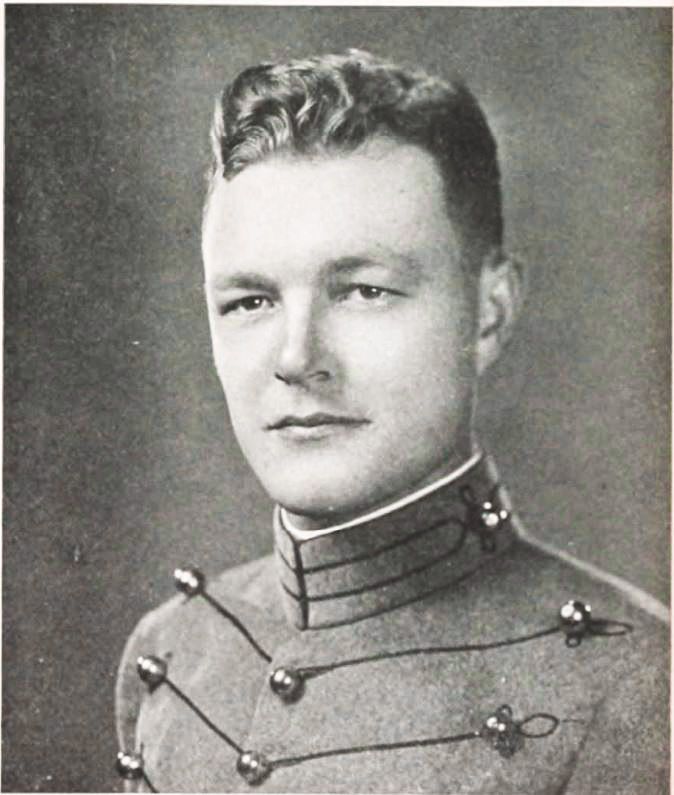Horace Grattan Foster, Jr. was born October 11, 1916, at the Presidio of San Francisco. From West Point Preparatory School at Fort Scott "Race" proceeded to West Point and was graduated with the class of 1941. He selected the Air Corps, and received his training in Santa Maria, Moffett Field, and Stockton (all in California); in Phoenix, Arizona; in Butte, Montana; and in Utah and Colorado.
Foster's active war service began when he was ordered overseas from Florida, first to North Africa, thence to China.
Lieutenant Colonel James E. Maher, who was with him on his final mission, told of the circumstances surrounding the death of Major Horace Grattan ("Race") Foster, Jr.:
"On August 21, 1943, the 308th Bombardment Group was directed by General Chennault to bomb the Japanese airdrome at Hankow, China. Early that morning a flight of seventeen B-24's took off from bases in western China and proceeded to their target. Unfortunately, due to weather conditions at the forward Fighter Air Bases, the Fighter escort was unable to take off, and it became necessary for the bombers to proceed to the heavily defended targets alone.
"Just before reaching the target area, the B-24's were attacked by approximately 80 to 100 enemy aircraft. A very fierce battle, which lasted for almost an hour, took place, and two of the B-24's were shot down, including the group leader. The Japanese always tried to knock out the group leader first, in order to disorganize the formation. The 308th Bomb Gp lost two aircraft, and many of the returning planes carried dead and wounded personnel. However, a total of 59 Japanese Fighters was destroyed, with approximately an additional 13 probables.
"General Chennault, after hearing the details of the mission, decided that another raid on Hankow would reduce the enormous fighter strength the enemy held there. It was decided that all B-24's, B-25's and P-40's would be used in an attack on the morning of August 24th. Major 'Race' Foster, who was Group Operations Officer, pleaded with the Group Commander to be allowed to lead the B-24's, knowing full well that the lead airplane would be heavily attacked, and the flrst one attacked. His duties as Group Operations Officer were many, and of great importance; but, throughout his combat career, he often and continually asked to lead Group formations, even though this was not his duty. The Group Commander at first refused; but finally, under 'Race's' urging, permitted him to go.
"The B-24's took off early that morning, but due to weather conditions at an airdrome which was located in a valley, only seven planes proceeded to Hankow. At the rendezvous point the B-25's and the Fighter aircraft were picked up, and the Group entered the target area, with the B-25's leading, and the P-40's flying top cover. During the target run, the B-25's and the P-40's went away from the initial target, and Major Foster pressed home his attack on the correct target, in spite of the fact the seven B-24's were without fighter cover. Once again the enemy hit the American planes with approximately 60 to 70 Fighters, and pressed their attack heavily, on the unescorted B-24's. Several B-24's were shot down right over the target, but the others fought their way through, and started towards home. When the B-24's thought their pursuers had returned to their base, a single Zero appeared from the clouds directly in front of ‘Race's' aircraft. The Zero fired his machine guns, mortally wounding Major Foster.
"In spite of the fact he was unconscious; and, where any ordinary person would have died immediately, Major Foster continued to try to fly the aircraft until forcibly pulled from his seat. The co-pilot took over the controls, and landed the plane at the foremost American airdrome. Here an excellent Flight Surgeon treated Major Foster in every way possible, but knew the case was hopeless. To the surgeon's amazement, Major Foster fought for life from approximately 1:15 in the afternoon until about 10 o'clock that night. The Flight Surgeon later said that it was the most amazing, and normally impossible, display of raw courage and indomitable will to live, that he had ever seen or heard of.
"Major Foster's body was flown to Kunming, China, the next day and be buried in a vault there, in the American cemetery located at the north of the runway."
Maj. Foster's remains are now buried in the United States Military Academy Post Cemetery, West Point, Orange County, New York, USA. He was one of over 2000 Americans who lost their lives defending China from their Japanese invaders from 1941-1945. He is commemorated on the The Monument to the Aviation Martyrs in the War of Resistance Against Japan in Nanjing, China.
Source of information: www.findagrave.com

PRIVATE CITIZENS SUPPORTING AMERICA'S HERITAGE
American
War Memorials Overseas, Inc.
War Memorials Overseas, Inc.
Foster Horace Grattan, Jr.
Name:
Horace Grattan, Jr. Foster
Rank:
Major
Serial Number:
Unit:
425th Bomber Squadron, 308th Bomber Group, Heavy
Date of Death:
1943-08-24
State:
California
Cemetery:
United States Military Academy Post Cem., NY
Plot:
Section VII
Row:
Grave:
103
Decoration:
Comments:
